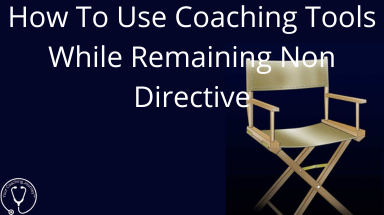Prefer to listen?
This blog post forms the basis of a podcast on our new coaching model, which you can listen to here.
We regularly talk about coaching tools on our podcast and in our blog articles. Because we also advocate for a non-directive approach to coaching, we are sometimes asked by our trainees how we can introduce a tool, model, concept, or an exercise without being directive.
Isn’t introducing one of these elements in itself directive?
In this article we will share our thoughts on, firstly, how the tool itself can be used in a non-directive way, and secondly, how we introduce them in a way that maintains that non-directive approach to coaching.
What does it mean to be non-directive?
It’s interesting to pull back a little bit and think about what being non-directive in the coaching room means. The phrase originated with Carl Rogers and the person-centred approach. His original approach to therapy was non-directive because he didn’t want to do the psychoanalysis that Freud and Jung had been doing. He called his approach non-directive. But then quickly thought, actually, this is a bit negative, it sounds like I’m trying not to do something and I want to be doing something positive. So that became the person-centred approach rather than the non-directive approach.
In life we are all quite directive in the way we go about having conversations with other people when they have a predicament, we tend to jump into rescue mode or solution-focused mode and want to come up with advice. If we’re in a coffee shop with someone and they’re saying, ‘I’ve got this real problem. I don’t know what to do’. We automatically say, ‘Well, you know what you need to do? You need to do this’, or ‘Have you tried this?’. We’re all very used to that way of being.
For most people, that’s the starting point, of being directive. The non-directive approach is the opposite, not giving any advice at all.
Our doctors are really used to giving advice. Which is a good thing, that’s generally what we want if we go to a doctor.
If you’re a health coach or involved in lifestyle medicine you will most likely be providing some information about what is good for someone’s health, and what is good practise to improve one’s health and wellbeing.
What we’re trying to introduce people to in terms of coaching, and get them to embed in the way they talk to people, is a non-directive way of being. As coaches, we’re holding that space for someone whilst they generate their own thinking and come up with their own answers to life’s problems. And that will include their thinking around information that may well have been shared with them by their health or lifestyle medicine coach.
So if we think about the content of the conversation, we’re not being directive about what they’re going to do, what action they’re going to take, or how they should think about it.
But we’re going to have to be directive about the coaching process.
We have to manage the coaching conversation and help to move our client’s forward in their thinking.
Tom’s example of using a model or tool to invite more thinking:
I was coaching someone recently, and it was about a relationship issue in the workplace. I asked him whether he was familiar with transactional analysis and the parent-adult-child model, which he wasn’t. I said, ‘Well, it’s a model that looks at relationships’.
I pulled it up on my laptop – I’ve got a PDF with that model on it – and talked him through the various elements. I said, ‘It’s a model that helps frame relationships, perhaps look at it from a different perspective’. I talked it through with him and he said, ‘Oh, no, that makes perfect sense now’.
I wasn’t telling him what he should think about the relationship. I wasn’t telling him that he was being a child. It was just presented the model. He said, ‘I get that. What I want to be doing is having those adult-to-adult conversations with my boss’. As the coach, I didn’t have to say that, he realised that.
There are two ways in which we can integrate tools, exercises and information sharing into coaching without it being us saying ‘I’ve got a solution for you’ or ‘I’m going to give you advice’. Firstly, there’s the way that your knowledge of the tools inform your coaching, perhaps by helping you understand what questions to ask, without explicitly sharing information with your coachee.
And secondly there’s the possibility of inviting your coachee to explore the information, model or tool to help them gain some new perspective or thinking about their situation.
We believe that it’s part and parcel of coaching to facilitate perspective taking on the part of the coachee and if we can do that by introducing a tool, then I think that’s perfectly valid way to work. And it’s non-directive because we’re not telling them what they should think or what action they should take.
In the world of health coaching and lifestyle medicine, and in positive psychology coaching, we might be prompted to share something that is really useful and that perhaps the person might need or want to be aware of, then we invite an exploration around that topic using coaching questions. So the ideas and thoughts that come up are theirs, no yours, or even someone else’s.
Danger Zones
We have to be careful, there is a danger that in introducing any model or any tool that we could end up being directive. If we start to share our thinking around the topic, or interpret it for the client, that’s directive. For example, in sharing the parent-adult-child model, if we say ‘well, clearly, she’s being the parent, you’re being the child, that’s never going to work, is it? You need to be adult to adult’.
That’s directive!
It’s the same with introducing health tools. It could be implied because you’re introducing the tool that you think people should act in a certain way. That’s something that we have to be aware of and try to stay clear of.
What we will also do is offer people the invitation to do certain things before they come to coaching, or between sessions to get them thinking about the coaching. They’re not directive in terms of what they should be thinking or doing in relation to their ‘problem’. They are invitations to think about thinking and bring those thoughts along to the session. We might not use them. We might just end up in a conversation.
And here’s another danger area. If we have asked someone to do something before a session, we must hold it lightly, we can’t say, ‘Hang on a minute, I’ve got a tool. I wanted to do the tool this week’. It might not be appropriate, and it’s highly likely you won’t be serving your client.
If a coach has a programme and they plan to explore your values in the first session, that can be too rigid an approach. We need flexibility, we have to go with the coachee and how they’re coming into the room. We’re coaching the person that shows up in that moment.
Helen likes to set a bit of homework for her clients:
It’s an invitation to play between sessions, to play with ideas or tools. It might be drawing something, it might be reflecting. It might be going on a little mini adventure. It depends. But again, it’s an invitation. It’s not essential. I still have clients now who, if we’ve ever bumped into each other or spoken since our coaching has finished, will say to me, ‘I never did do that journaling thing you told me about’. That’s absolutely fine because that clearly wasn’t for them at that time. It was simply an invitation to explore something.
Is telling someone to journal directive?
We’ve talked about journaling before on our podcast and in an article, but is saying, ‘we know that journaling can help to clarify thinking, and maybe that’s something that you could do between this session and the next session’ being directive?
Again, you’re not telling people what they should be doing.
But you could be seen to be saying you should be journaling.
However, if you look at the outcome they want from your time together, their intentions for your coaching, you’re not saying, ‘well, that’s easy. I can fix it. All you need to do is some journaling’. You’re saying ‘journaling is a tool which might invite more thinking in between sessions, and the writing down of that thinking that happens anyway between sessions’.
We don’t believe that the thinking just happens in the coaching room. We want people to carry on with their thinking. We know they will anyway, but, by inviting them to try journalling, we are actively encouraging them to keep thinking.
We’re slightly hesitant to say it’s completely non-directive because I think there is a degree to which we’re directing the activity. But in the same way that we’re offering an invitation for them to do some pre-coaching work, ‘here’s an exercise you might want to do before we start’, we can offer for them to try journalling between sessions.
What we would not do is expect them to share that journalling.
It’s not essential to the coaching process that the journaling is done, and in that way, it’s not directive.
As the coach you are directing the conversation to a degree, you’re managing it. If someone is sitting in front of you and they’re going off at a tangent and they end up just gossiping, which happens sometimes, then we might want to bring them back on track because if it’s not relevant to what we’re talking about, it’s just gossip. We’re just having a chat. It’s not a conversation with a purpose anymore.
We’re definitely, as a coach, being directive of the process.
How We Might Explore A Tool With A Coachee
Sometimes we might introduce a tool, but we still want to coach around the tools. We want to share them as a useful addition that is going to move their thinking forward.
- We send a wheel of life or profiling tools like a strengths finder/profiler to a client before a session.
- They fill it out and perhaps send it back to us.
- We’ll take a look at it, but it means nothing on its own because we don’t know what they’re making of it.
- If we were having a coaching conversation around it, we might pull it up on the screen and be asking them questions about it, about what they made of it, what insights they had, what they found surprising, what they’re disappointed in.
- There is a great opportunity there for them to increase their self-awareness through this tool, and through the coaching conversation we have around it.
- We’re still using coaching questions, still keeping it open, still eliciting new thinking and that movement forward.
It’s still not about us being the expert and knowing what’s best and advising them of what they should be doing.
The key is that we’re facilitating the process, perhaps even being directive about the process but never in terms of what people should be doing with their lives. That’s for them to decide, but we can give them some activities to do that might help clarify their thinking and open up the conversation in the coaching room.
To find out more about our Doctors’ Transformational Coaching Diploma click through here



